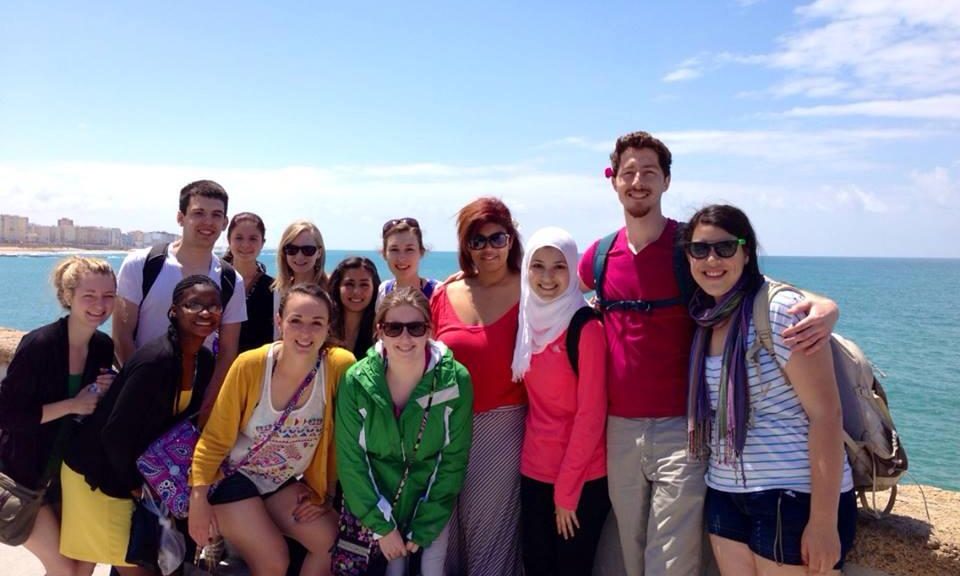


Since my last post, Carlos has sent me his recipe for Paella along with a picture of the dish he made once in the US. It has been decided that we will have to bring him back with us; now we just have to tell him!
Ingredientes para 4 personas (variables):
1 pimiento verde, 1 pimiento rojo, 1 cebolla no muy grande, 2 dientes de ajo, una lata de tomate triturado, arroz tipo bomba (tiene el grano más circular), unos hilos de azafrán, aceite de oliva, un poco de vino blanco, caldo de pescado, selección de marisco (200 gr. de anillos de calamar, 8-10 mejillones, 250gr. almejas, 250 gr. de gambas arroceras, 150 gr. langostinos).
Calentar el aceite en la paellera, cuando este caliente introducir el marisco y calentarlo ligeramente (no mucho, si no cuando lo volvamos a introducir con el arroz puede que se nos quede seco o sin sabor). Esto lo hacemos para que el aceite coja el sabor del marisco.
Sofrito: Con el mismo aceite del marisco, cocinaremos los pimientos, la cebolla, el ajo y el tomate que deben de estar previamente cortados (en el caso del tomate, podemos usar tomate triturado). La clave del sofrito es hacerlo con tiempo y sin frisas dándole a cada ingrediente el tiempo necesario para que alcance el punto de cocción adecuado y se reduzca creando una combinación en la que cada ingrediente aporte una nota clave.
Una vez el sofrito este listo, debemos añadir la suficiente agua como para que el arroz consiga estar en su punto. Añadimos el caldo de pescado, una copita de vino, unos hilitos de azafrán y el marisco de nuevo. Finalmente echamos el arroz (400gr) y ya solo nos queda esperar y disfrutar.
Se pueden cortar unos limones que funcionan de manera decorativa o también para añadir al gusto.
(Disclaimer: This post was written Friday, Jun 7th. Finding internet has been part of the journey.)
“Tapas on Tapas on Tapas.” That would be my answer for anyone asking what food I have been eating during my time here in Córdoba, Spain. Well that and “potatoes,” which have accompanied every lunch and dinner thus far. In the past six days, us students have tested out (and misinterpreted) many of the tapas dishes on menus at Loyola Andalucia and at the restaurants in the beautiful city around us. As I continuously order what I think is one plate and receive what turns out to be another, I slowly start to understand that, in España, Flamenquin is unrelated to Flamenco dancing and Tortillas are not used to create quesadillas. So far my list of favorites include a good Salmorejo (a tomato sauce with olive oil, garlic, bread, ham and egg), tortillas de camarones (a baby shrimp omelet), and Secreto Iberico (pork).
Dishes like these have provided half of the joy I’ve experience so far, but one meal that recently moved to the top of my favorites list is Paella. Paella is simply rice and seafood but its unique seasoning provides a rich flavor that lasts until the pot is empty. The dish takes hours to prepare, but when each flavor begins to mix and set in with another, it is impossible to pass up. I personally thought that I wouldn’t go near such a recipe with my dislike for onions and peppers, but it was definitely worth it. Just last night, the Loyola Chicago students studying abroad in Córdoba, local students helping with our assimilation, and other local friends we’ve made in the past few days gathered for a fiesta on the rooftop of the student apartments. On that night, we brought out the cerveza, opened the vino, and I made home made slushies with piña colada juice! We shared laughs, we shared at least a basic understanding of two languages, and we shared Paella. The picture above shows (from left to right) Antonio Torres, Rafa Cuesta, Jose Maria Martinez, and Carlos Fuentes-Guerra, who worked on this dish almost all night. When is was done, we grabbed forks and ate strait out of the pot until there were just bits of rice left. Talk about community bonding.
The food we had on that night was amazing, but it was especially important to me that I practice my spanish in all possible ways. It just so happens that today I’ll be practicing how to ask Carlos for the recipe so I can bring it home to my mother! Spanish dishes are definitely growing on me, but before I end, here are a few tips if you are ever ordering in spanish: “sangre” is very different from “sangria” and “huevos” are not the same as “huesos!”
Until next time, Adios!
-Lydia (or Lidia now that I’m in Spain ;])
Walking down the streets in Rome can be quite confusing. Streets are packed with buses and cars. Then these streets intercross with more narrow roads. There are mopeds beeping behind you trying to get through. A man offers for you to buy scarves on your right. The smell of scrumptious pizza tickles your nose from the left. Rome can be quite crazy sometimes, but in the craziness you can discover little gems in between. And to me, these little gems are the beautiful churches.
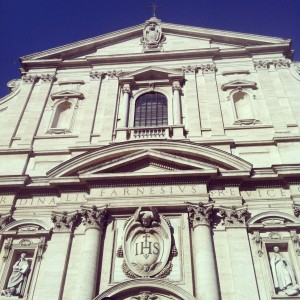
The churches in Italy are certainly something you don’t see in the States. They’re older. They’re full of art and history. And there’s so many of these wonderful churches! Every Tuesday at the JFRC campus, students had the opportunity to take a walk with Father Bosco. These walking tours have given me the chance to learn more about Catholicism and its history. All these churches were beautiful and I never knew I would spend so much time enjoying these tours. Not to mention, Father Bosco has particular knowledge of the most delicious gelaterias.
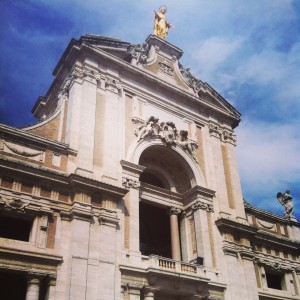
The Assisi Day Trip was another opportunity for JFRC students to see some churches outside of Italy. We visited the Basilica of San Francesco d’Assisi, which included three churches. In addition, we visited Santa Maria degli Angeli. Why are all these churches so gorgeous? I honestly can sit inside for hours to look at every detail. The architecture of these churches is unbelievable sometimes.
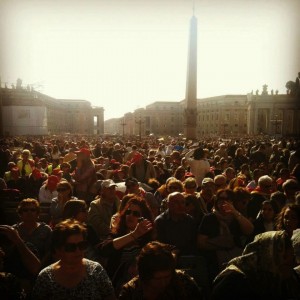
Since we’re in the topic of religion, I have to mention my day at the Papal Audience last Wednesday. JFRC usually tries to arrange Papal Audience tickets for students. A group and I walked to the Vatican early in the morning and ended up being second in line. But, lines don’t necessarily mean order in Italy. As soon as the gates opened, the elderly women behind me began to push with much strength as I wiggled my way in through the running crowd. Despite the chaos, we managed to find seats in the first five rows.
The Papal Audience was certainly a unique experience as there were people from all over the world. Even during the blessings, it was translated in English, Italian, German, Spanish, and many more languages. The beauty of the ceremony made me realize how universal religion really is. Many people traveled around the world to see Pope Francis and to see people moved by the Pope made the experience even more extraordinary.
Next week will be my last days in Italy. I’m leaving on Friday morning and it’s weird to think how much I adjusted to the Italian life. There’s so much more I want to do even if I have done a lot in five weeks. I’m now off to Venice to celebrate the last weekend in Italy! Ciao!
My time in Monteverde was quite possibly one of the best experiences I have ever had. It is a place like nothing else in the world filled with trees and houses on a mountainside. Monteverde is a very small town, located in the mountains of the province of Puntarenas. It is one of the most famous ecotourism spots in the world. This was another one of our USAC sponsored trips so they provided transportation. The bus ride itself was an experience due to the high altitude and steepness of Monteverde’s location on top of the mountains. At times I felt like we were driving up a hill with a 90 degree angle. The views were spectacular though and the ride only lasted about three hours or so. When we arrived, we were each assigned a cabin. I roomed with two other girls, and I was lucky enough to have the queen bed, which was a nice change from the twin bed I have been in for the past three weeks. We were so high up in the mountains that when we looked out our window, we were in clouds.
Our first excursion in Monteverde was a hike through the famous Monteverde Cloud Forest. It only cost us $4 because we are USAC students. I did not see as many animals as I would have liked, but I did witness some awesome plants and insects. We saw several strange looking caterpillars and incredibly tall trees with exposed roots that continued on for miles. When we got to the top of the trail, I was expecting an immaculate view, but alas I was greeted with clouds. I guess it was a semi fair tradeoff since I did see the whole countryside on the ride up the mountain. It is just super peaceful to walk around in a biodiversity hot spot that is so well preserved that you forget you are walking on a path in a national park. Costa Rica should be proud of their dedication to protecting the environment and preserving biodiversity. I will treasure the memory of being inside nature’s lungs, the rainforest.
After the two hour hike, we headed back to our cabin and went to the “downtown” area of Monteverde, which was literally a five minute bus ride. We bought some overpriced souvenirs which included a wooden mug with a parrot on it that I convinced myself I had to have. We had dinner at a bar and I had the strangest concoction. I love the fried plantains here which are called, “patacones,” so I ordered a plantain sandwich type thing. It was not very appetizing due to the fact it was smothered with cabbage and watery refried beans. I definitely prefer the patacones that I have eaten in Puntarenas. We ended the night with dancing at Bar Amigos, probably the most exciting night I have had since I have been here.
For our last day in Monteverde, we went ziplining in the Monteverde Cloud Forest Reserve. It is something I will never forget. We did about 10 or 11 different ziplining rides throughout the whole forest, totaling about 1.5-2 hours. Many of the rides lasted about 20 or 30 seconds, which is a lot when you consider you were practically flying through mid-air above treetops. I definitely felt like Tarzan, but in lieu of vines I used ziplines. To be overlooking such a massive rainforest rich with biodiversity is breathtakingly spectacular, and makes you appreciate how amazing our planet is. For the remainder of the afternoon, we went to the amphibian and reptile exhibit in Monteverde. We learned about all the different types of snakes, frogs, and lizards that live in Costa Rica. They have some vicious poisonous snakes here that have the ability to make you go brain dead or venom that will literally eat away at your skin and organs. Luckily they mostly just come out at night, and most of them live in the rainforest. I had the opportunity to hold a baby snake at the end and it was surprisingly adorable despite my fear of snakes.
For our first USAC led trip in Costa Rica, we went to Tortuga Island. It is called Tortuga Island because tortuga means turtle in Spanish, and the island itself is shaped like a turtle. We traveled there by boat, which was either a great adventure or the worst experience of your life depending on your sensitivity to motion sickness. I was on the smallest boat and really enjoyed the ride. It was about an hour and a half boat ride to Tortuga Island from Puntarenas. It was a bright sunny day, and the wind from the boat ride was a nice change from the hot, humid weather in Puntarenas.
When we arrived, the first thing we did was go snorkeling. I absolutely loved it. We literally swam alongside entire schools of fish. We saw some Dory fish from Finding Nemo, and there was a school of hundreds of little minnows under the boat. The fish did not even seem to be phased by us snorkelers, implying that it was really their ocean and we were merely visitors. After we finished snorkeling, we spent the rest of the day at the beach. The beach at Tortuga is fabulous. The water is a crisp, cerulean blue and the sand is practically white. The island itself is quaint and is definitely a hot spot for tourists. We walked around the island, attempted to take a few action shots jumping on the beach, ate a catered lunch, and went tubing. Growing up in Kansas near a lake, tubing was a common past time for most kids growing up. However, tubing on a huge hot dog tube in the Pacific Ocean surrounded by mountains and islands compares to nothing I have ever experienced.
All I’ve been wanting to do this week is sing “The Sound of Music” while frolicking along the grassy hills. I guess that’s what happens when you spend time in the mountains. Last weekend, I had the opportunity to travel in Abruzzo, one of Italy’s most mountainous regions. The study trip was organized by the JFRC and led by Professor Jim Schwarten.
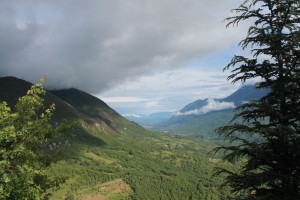
Hiking, of course, was the main activity on the trip. I’ve never been hiking before so it was a great, new experience. The scenery was absolutely gorgeous. We hiked through the trees and even if it was rainy, we got a chance to see the longest waterfall on the Central Apennine mountains. The next day, we climbed atop Mount Viglio. We were so high up that we were in the clouds. It was awesome! Hiking gave me a new appreciation for beautiful nature. I wanted to spend a hours staring at the mountains in a dream-like state.
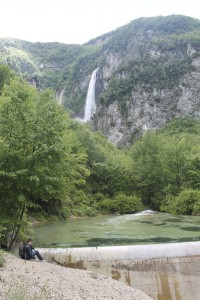
Another favorite part of the Abruzzo Trip was spending time in an Italian village. We got to visit Civita D’Antino, a small town located on a hill. Village life is obviously different from city life. Everyone knew each other and they were so friendly to us tourists. Musicians gave us a mini concert of classic Italian mandolin and guitar music. The group and I ate at the same local restaurant for dinner and they provided us with traditional (and delicious) Italian dishes. We even learned how to make gnocchi.
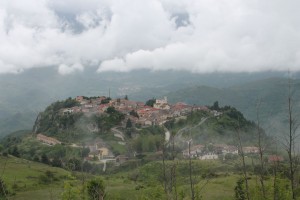
The vibe of the village was completely laid-back. It gave us a chance to slow down and enjoy that we were in Italy. The Abruzzo study trip also gave me more time with the other JFRC students. Who knew playing a card game of Scopa could bring a group of us together? I honestly never would have thought to have that experience on a weekend trip. If you plan to study at JFRC, sign up for their study trips. It’s worth the money.
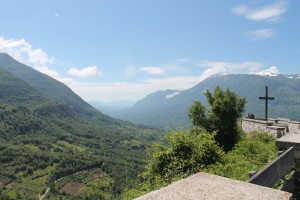
I’m almost done with midterms week, so I’ve been spending the last few days at the IC and grabbing pizza for dinner. I can’t believe I only have two weeks left in Italy. Where did the time go? This weekend I’ll be visiting Assisi and other places. I’ll talk about it more next week!